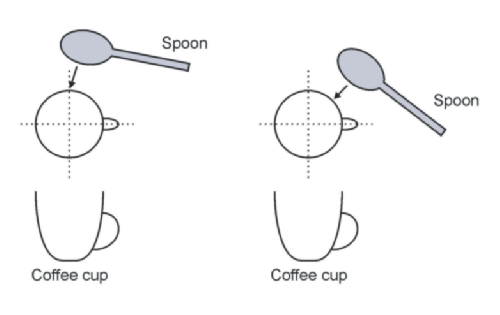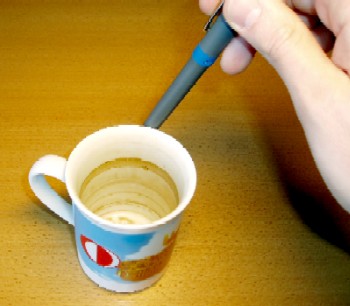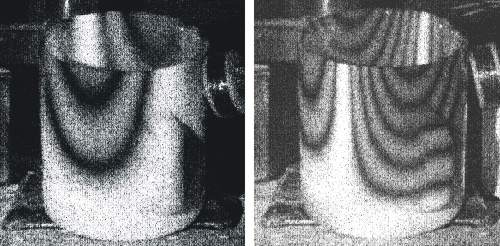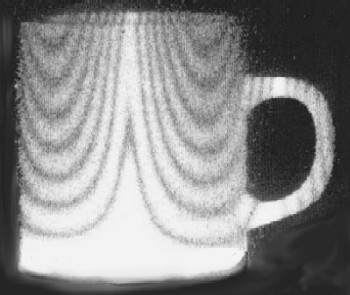 |
|
|
  
Demonstration no.: 92 Description: If you strike the side of a coffee cup with a spoon, the cup will start vibrating. The vibrations are so small that you cannot see them with the naked eye, but the opening of the cup actually vibrates so that its shape changes between a circular and an elliptic shape. This is a standing wave around the circumference of the cup. Though the vibrations are too small to see, you can hear them. The vibrating cup makes the surrounding air oscillate, thus creating sound. You can then hear the cup "sing" with the same frequency as the vibrations. If the cup is completely symmetric, the cup will "sing" with the same frequency independent of which side the cup is struck. This, however, is not the case if the cup has a handle. 
Two different modes of oscillation can be excited in a coffee cup dependent on where the cup is struck.
The handle of the cup has an effect on the oscillations of the cup. When the cup vibrates, the standing wave around the edge of the opening will have four nodes and four anti-nodes (in the fundamental mode).
Flash animation: Standing wave in a coffee cup. The fundamental mode of oscillation consists of four nodes and four anti-nodes. If the handle of the cup coincides with an anti-node, the handle will have to move, thus slowing the vibration (low frequency oscillation). If the handle coincides with a node, the handle will not affect the oscillation, resulting in a fast (high frequency) oscillation.
If the cup is struck opposite to the handle, the handle will coincide with an anti-node. Since the handle is an extra weight to move, this will slow the oscillation. If the handle coincides with a node, the oscillation is not affected. 
With a pen a standing wave in a coffee cup is excited.
Notice that you can strike the cup several places. If the cup is struck opposite the handle or 90 degrees to each side, you excite one oscillation. If the cup is instead struck 45 degrees to each side, another mode of oscillation is excited. To visualize the oscillations in the cup, it is possible to take pictures using a special technique called holographic interferometry. This has for instance been done by two American scientists, who have supplied the following pictures to Fysikbasen: 
Pictures of standing waves in a cup recorded with holographic interferometry. In one picture, the handle coincides with a node of the wave; in the other with an anti-node. By courtesy of Dr. Andrew Morrison and Dr. Thomas D. Rossing of the Northern Illinois University, USA.

Another picture recorded with holographic interferometry. In this picture, the handle coincides with a node. By courtesy of Dr. Andrew Morrison and Dr. Thomas D. Rossing of the Northern Illinois University, USA.
Equipment and materials:
References:
PIRA DCS: 3D40.00 (Oscillations and waves: Instruments) Updated: 19 August 2007 If you have comments, corrections or suggestions regarding this demonstration, |
| FYSIKBASEN.DK was updated on Sunday, 16 June 2008, at 23:01. |
 Standing waves in a coffee cup
Standing waves in a coffee cup Coffee cup
Coffee cup